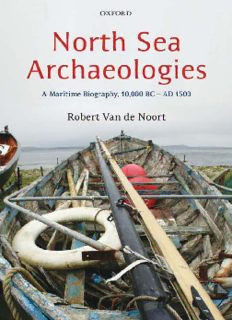
North Sea Archaeologies: A Maritime Biography, 10,000 BC - AD 1500 PDF
Preview North Sea Archaeologies: A Maritime Biography, 10,000 BC - AD 1500
NORTH SEA ARCHAEOLOGIES This page intentionally left blank North Sea Archaeologies: A Maritime Biography, 10,000 BC to AD 1500 ROBERT VAN DE NOORT 1 3 GreatClarendonStreet,Oxfordox26dp OxfordUniversityPressisadepartmentoftheUniversityofOxford. ItfurtherstheUniversity’sobjectiveofexcellenceinresearch,scholarship, andeducationbypublishingworldwidein Oxford NewYork Auckland CapeTown DaresSalaam HongKong Karachi KualaLumpur Madrid Melbourne MexicoCity Nairobi NewDelhi Shanghai Taipei Toronto Withofficesin Argentina Austria Brazil Chile CzechRepublic France Greece Guatemala Hungary Italy Japan Poland Portugal Singapore SouthKorea Switzerland Thailand Turkey Ukraine Vietnam OxfordisaregisteredtrademarkofOxfordUniversityPress intheUKandincertainothercountries PublishedintheUnitedStates byOxfordUniversityPressInc.,NewYork #RobertVandeNoort2011 Themoralrightsoftheauthorhavebeenasserted DatabaserightOxfordUniversityPress(maker) Firstpublished2011 Allrightsreserved.Nopartofthispublicationmaybereproduced, storedinaretrievalsystem,ortransmitted,inanyformorbyanymeans, withoutthepriorpermissioninwritingofOxfordUniversityPress, orasexpresslypermittedbylaw,orundertermsagreedwiththeappropriate reprographicsrightsorganization.Enquiriesconcerningreproduction outsidethescopeoftheaboveshouldbesenttotheRightsDepartment, OxfordUniversityPress,attheaddressabove Youmustnotcirculatethisbookinanyotherbindingorcover andyoumustimposethesameconditiononanyacquirer BritishLibraryCataloguinginPublicationData Dataavailable LibraryofCongressCataloginginPublicationData LibraryofCongressControlNumber:2010937009 TypesetbySPIPublisherServices,Pondicherry,India PrintedinGreatBritain onacid-freepaperby MPGBooksGroup,BodminandKing’sLynn ISBN 978–0–19–956620–4 1 3 5 7 9 10 8 6 4 2 Preface The aim of this book is to explore how an archaeological study that is focused on a fluid maritime landscape differs from one based on a solid terrestrial landscape, and what we—as archaeologists who overwhelmingly liveandworkonland—canlearnfromsuchastudy.Fromtheoutset,itneeds emphasizingthatthisstudydoesnotpresumethatlandandseaweremutually exclusive realms, or represent genuine or metaphorical opposites in the past orpresent.Theseaitselfistoodynamic,itsedgesaretooblurred,andpeople’s knowledge of the sea has always been far too great for such a concept to be given muchvalidity. Nevertheless, thesea is different from theland in many different aspects: the sea is active and dynamic, often unpredictable and unreliable;itcontinuestobeaco-constructoroflandscapes;itoffersadeviant placewheretheestablishmentfounditdifficulttoexerciseitspowers;anditis a place where special skills and knowledge are required, not held by those unfamiliar withthe sea.In thesesenses,the seaisan alternativespacewhere onecanexplorewaysinwhichpeopleinthepastengagedwiththeworldthey inhabited. TheselectionoftheNorthSeaasthefocusforthisstudyrelatesdirectlyto my own background. Over the past three decades, I have worked as an archaeologist on the opposite sides of the North Sea. As a student, and in myearlycareer,IparticipatedinanumberofexcavationsontheDutchcoast andthecoastalhinterland.Later,throughtheworkoftheHumberWetlands Project,IbecamefamiliarwithEngland’seast-coastarchaeology.Thediscov- ery of a fragment of a Bronze Age sewn-plank boat on a beach in East YorkshirebyRichardMiddletonin1997,andmyinvolvementinthepublica- tionofwhatwecalledthe‘Kilnseaboat’,drewmyattentiontotheNorthSea proper. Researching theliterature on Bronze Ageboats, I realized the wealth oftheresourceofferedbythesecraftandhowlittleendeavourhadbeenmade toplacetheseintobroaderarchaeologicalcontexts.This,inturn,ledtoideas onthetransformativepowersoftheNorthSea. Some of the arguments presented here have been aired at conferences and presentations around the North Sea basin, and the debates that ensued from these are recognized for having helped to shape this book. I also wish to acknowledgetheparticipantsoftheEnglishHeritageMarineResearchFrame- workprojectfortheirknowledgeandwisdom.Iamparticularlygratefultothe following who read and commented on draft chapters: Bryony Coles, Alan Outram,HansPeeters,JasonRogers,StephenRippon,FraserSturt,andChrister Westerdahl. As always, I am indebted to Jess Collins for improving on my EnglishandtoMichaelRouillardforproducingtheline-drawingsandmaps. vi Preface IwishtothankAmyBallandAndrewMackayattheCravenMuseumand Gallery,Skipton,foraccesstothetwosmallaxesfromtheDoggerBank,and David Field (English Heritage) for drawing my attention to these. Others, including David Campbelland Toby Heppel,Ithankfor making meexplain things simply. Finally, I wish to thank my sons, Will and Michael, for their companionship on the trips to the Oslofjord, the (cid:2)stfold and Bohusla¨n in 2006, the east coast of Jutland in 2007 and the Shetland and Orkney archi- pelagosin2009thatcompletedmyresearcharoundtheNorthSea. Contents Listoffigures ix Listofabbreviations xi Notetothereader xiii 1. Introduction:theseais‘goodtothink’ 1 2. Anarchaeologicaltheoryofthesea 21 3. Theseaasadynamicandhybridlandscape 44 4. Fish:exploringtheseaasataskscape 72 5. Socializingcoastallandscapes 98 6. Archipelagosandislands 125 7. MovingacrosstheNorthSea 146 8. Thedaily practiceofseafaring:theshipasheterotopia parexcellence 178 9. Theculturalbiographiesofboats 201 10. Conclusions:amaritimebiography 228 Bibliography 241 Index 271 This page intentionally left blank List of figures 1. TheNorthSea:theFrisians’view 5 2. Placesandregionsmentionedinchapter1 6 3. FirstimpressionsoftheNorthSea 8 4. AtopographicandbathymetricmapoftheNorthSearegion. 10 5. TheculturalbiographyofaboatI 39 6. TheculturalbiographyofaboatII 40 7. Placesandregionsmentionedinchapter3 45 8. Thereconstructeddevelopmentof‘Doggerland’ 46 9. RedrawnversionofClementReid’smapoftheNorthSeawith thecoastline‘attheperiodofthelowestsubmergedforest’ 48 10. VariantsonHolocenesea-levelchange 50 11. ThereconstructeddevelopmentoftheNorthSea 52–3 12. ArchaeologicalfindsfromViking-Bergen,StoreFiskebank,and theLemanandOwerBank 56 13. ArchaeologicalfindsfromtheBrownBank 58 14. TwosmallaxesfromDoggerBank(heldinCraven Museum,Skipton) 59 15. Placesandregionsmentionedinchapter4 74 16. ThedistributionofmiddensintheNorthSeabasin 76 17. Reproducedimageoftherockengravingoffishermenat Kville,Bohusla¨n 81 18. JulianThomas’s(1999)graphoftheMesolithic/Neolithic transition 90 19. Placesandregionsmentionedinchapter5 99 20. RubjergKundelighthouse,Jutland 100 21. Reconstructionof‘Seahenge’ 106 22. ReconstructiondrawingofFlagFen,Phase3,middlestage 107 23. FeddersenWierdePhase4 111 24. FeddersenWierde—layoutofahouseinPhase5 112 25. Schematicmodelillustratingtherangeofpotentialstrategiesfor theexploitation,modificationandtransformationofanarea ofcoastalsaltmarsh 117 26. Placesandregionsmentionedinchapter6 127 27. TheOrkneyandShetlandIsles 128
Description: